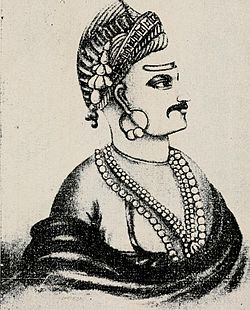
Back بيشوا (لقب) Arabic Peshwa Catalan Пешва CE Péšva Czech Peshwa German Peshwa Spanish پیشوا (امپراتوری مراتا) Persian Peshwâ French પેશવા Gujarati पेशवा Hindi
| Peshwa of the Marathas | |
|---|---|
| Residence | Shaniwar Wada, Pune (1732–1818) Bithur, Kanpur (1818–57) |
| Appointer |
|
| Formation | 6 June 1674 |
| First holder | Moropant Trimbak Pingle |
| Final holder |
|
| Abolished | 3 June 1818 (de jure) 16 July 1857 (de facto) |
| Succession | The Peshwas split into 3 dynasties after abolishment |
The Peshwa[a] was the second highest office in the Maratha Confederacy, next in rank and prestige only to that of the Chhatrapati. Initially serving as the appointed prime minister in the Maratha Kingdom, the office became hereditary after the death of Shahu in 1749. During the reign of Shahu, the office of Peshwa grew in power and the Peshwas came to be the de facto rulers of the Maratha Confederacy. However following the defeat of the Marathas in 1761, the office of the Peshwa became titular as well and from that point onwards served as the ceremonial head of the Confederacy underneath the Chhatrapati.[1]
All Peshwas during the rule of Shivaji, Sambhaji and Rajaram belonged to Deshastha Brahmin community.[2][3] The first Peshwa was Moropant Pingle, who was appointed as the head of the Ashta Pradhan (council of eight ministers) by Shivaji, the founder of the Maratha Kingdom. The initial Peshwas were all ministers who served as the chief executives to the king. The later Peshwas held the highest administrative office and also controlled the Maratha confederacy. Under the Chitpavan Brahmin Bhat family, the Peshwas became the de facto hereditary administrators of the Confederacy. The Peshwa's office was most powerful under Baji Rao I (r. 1720–1740). Under Peshwa administration and with the support of several key generals and diplomats, the Maratha Confederacy reached its zenith, ruling major areas of India. The subsequent Peshwas brought in autonomy and as a result later on many states were controlled and administered by the Maratha chiefs such as Scindias and Gaekwads.
In 1760, the peace of Peshwa government was broken by a rising of Kolis under their Naik Javji Bamble. Javji withdrew to the hills and organised a series of gang robberies, causing widespread terror and misery throughout the country. For twenty years he held out bravely, defeating and killing the generals the Peshwa's Government sent against him. At last he was so hotly pursued that, on the advice of Dhondo Gopal, the Peshwa's governor at Nasik, he surrendered all his forts to Tukoji Holkar and, through Holkar's influence, was pardoned and placed in military and police charge of a district of sixty villages with powers of life and death outlaws. In 1798, a fresh disturbance took place among the Kolis. The leader of this outbreak was Ramji Naik Bhangria, who was an abler and more daring man than his predecessors, and succeeded in baffling all the efforts of the Government officers to seize him. As force seemed hopeless, the Government offered Ramji a pardon and gave him an important police post.[4]
Cite error: There are <ref group=lower-alpha> tags or {{efn}} templates on this page, but the references will not show without a {{reflist|group=lower-alpha}} template or {{notelist}} template (see the help page).
- ^ Jaswant Lal Mehta (2005). Advanced Study in the History of Modern India 1707–1813. Sterling Publishers Pvt. Ltd. p. 314. ISBN 978-1-932705-54-6.
- ^ Prasad 2007, p. 88.
- ^ Vasant S. Kadam (1993). Maratha Confederacy: A Study in Its Origin and Development. Munshiram Manoharlal Publishers. p. 49. ISBN 9788121505703.
Under Shivaji the Great, Sambhaji and Rajaram all the incumbents of the office of Peshwa were from the Deshastha (residing in the Desh area of Maharashtra) subcaste of the Brahmans.
- ^ Hassan, Syed Siraj ul (1989). The Castes and Tribes of H.E.H. the Nizam's Dominions. New Delhi, India: Asian Educational Services. p. 333. ISBN 978-81-206-0488-9.
